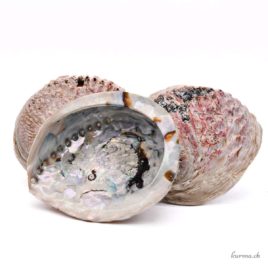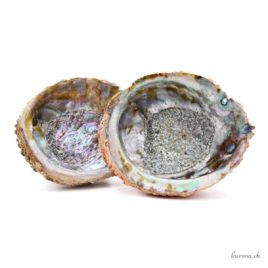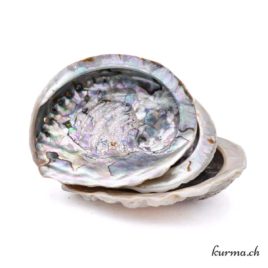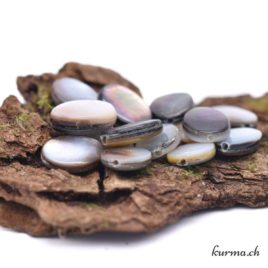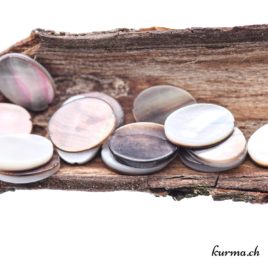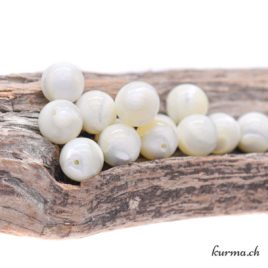Natural mother-of-pearl
white, black, brown, blue, green: Abalone, Paua or Pawa shells and others
Perceived as an ocean treasure, Abalone, Paua or Pawa shell nacre can be white, black, brown, pink, blue or green.
Its virtues in lithotherapy link it to purity, femininity,breastfeeding and physical and spiritual fertility.
- You cannot add this quantity to the cart - we have 1 in stock and you already have 1 in your cart. View cart
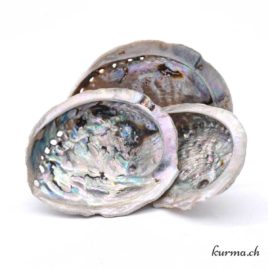
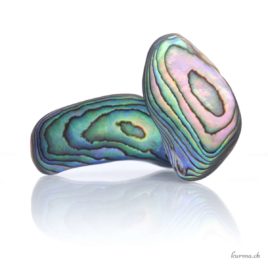
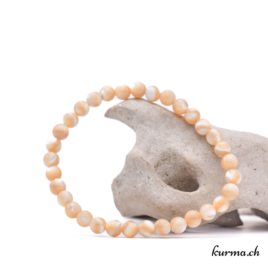
What are the benefits and properties of Mother-of-Pearl in lithotherapy?
Mother-of-pearl comes from the inside of the shells of certain shellfish and mollusks. It is characterized by its silky appearance, iridescent reflections and incredible resistance.
Abalone is the English term for abalone shells, whose mother-of-pearl comes in a multitude of colors.
What does it mean?
Mother-of-pearl symbolizes the treasures hidden within each of us. It represents fertility in all its forms; that of creating new life, as well as the ability to give birth and form to visions of knowledge or a new state of the world. It is femininity, purity and prosperity in this sense.
Abalone represents the great ocean goddess in Polynesia, where the shell is known as Paua or Pawa. The latter is native to New Zealand.
What are its benefits?
With Nacre, you're invited to re-connect with your deepest nature, with the hidden treasure within you, the treasure that radiates far and wide when you're in tune with who you are and what you want.
It teaches you that your sensitivity and vulnerability are invaluable and can become your greatest strength. To achieve this, Mother-of-Pearl encourages you to take care of yourself. It helps you to heal your wounds, especially sentimental wounds caused by a break-up with a lover, friend or family. It also helps you to "let go", to gain fluidity, to de-dramatize what can be de-dramatized, to develop qualities of tolerance and to free yourself from emotional or material tensions stemming from your past.
With its particularly soft appearance and luminous reflections, Mother-of-Pearl invites you to marvel at the surrounding beauty in your everyday life, to see the drop of water glistening in the sun, to hear the song of the chickadee in the early morning, to savor the smile of a child crossed on your path, or the magic of the first snowflakes.
It offers you a magnificent opportunity to open up and welcome the feminine side of yourself, which can harmonize and radiate in total freedom, with the power of your sensitivity and intuition as your resource.
The benefits of Abalone
In lithotherapy, Abalone adds particularly powerful repairing and purifying properties to mother-of-pearl. It strengthens the aura and etheric body, providing protection against undesirable energies.
Abalone is used by native Amerindian peoples for purification rituals through fumigation: herbs (sage, sweetgrass, juniper, cedar, etc.) are burned in the shell, and the smoke is diffused with a feather. In this way, the 4 elements are represented: water by the shell, earth by the plants, fire by the combustion, air by the feather and the smoke.
Physical properties in lithotherapy
On a physical level, Mother-of-Pearl can help with Calcium deficiency, promote healing, soothe allergies and skin rashes. It can be beneficial for improved fluid circulation and of great support during pregnancy, post-natally, and in cases of childhood illness.
It is also used to soothe migraines and visual disorders.
What are the breastfeeding properties of Mother-of-Pearl?
Mother-of-pearl, a beautiful symbol of prosperity and inner and outer wealth, has been used for millennia to promote fertility and maternal instinct.
During breastfeeding, it reassures and soothes mother and child in lithotherapy. It can then be worn as jewelry by the mother: a necklace, pendant or bracelet, with their restful and reassuring powers, will promote connection with the baby and a relaxed environment.
How do I use Mother-of-Pearl while breast-feeding?
You can carry it with you, as mentioned above, or hold it in your hand when you accompany the child, or meditate while he's sleeping.
You can also place it near the breastfeeding area, or put it for a moment on the nipples to protect them from increased sensitivity or to treat cracks. It' s important to note that, in the event of problems, this practice should not replace the advice of a doctor or health professional.
General use of mother-of-pearl
- Wear mother-of-pearl in times of stress or when you're feeling particularly tired.
- Contemplate an Abalone shell to connect with your intuition or to soothe worries or difficult emotions.
- For an invigorating and purifying facial, put water in your Abalone shell and place it under the light of the full moon. Wash your face with this water and a cotton pad. Or you can drink the water for a detox - if your shell hasn't been treated beforehand.
Which stone to match with Mother-of-Pearl or Abalone?
- To harmonize feminine energies, for pregnancy or menopause, combine it with Moonstone.
. - For love, healing of the heart and beauty, it pairs wonderfully with Rhodochrosite .
- For intuition and connection to industrial energies, chooselapis lazuli .
How to purify mother-of-pearl?
Shell reloading and cleaning
Moon, running water or seawaterChakras
All chakrasAstrological signs
Cancer, Scorpio, Aquarius and PiscesElement
WaterMother-of-pearl, its formation, composition and particularities
Mother-of-pearl is formed inside the shells of certain mollusks and mussels. It forms throughout the life of the shellfish and is made up of a stack of regular layers of conchyoline (a protein secreted by molluscs) and aragonite (calcium carbonate) crystals.
Mother-of-pearl's silky and iridescent appearance is due to its layered structure, which generates interference from light radiation.
The Abalone
(or red abalone shell Haliotis rufescens is characterized by a particularly shiny, iridescent and colorful mother-of-pearl. These peculiarities are due to the modification of the atomic structure of the calcium carbonate during its formation. Its shimmering colors come in shades of green, blue, violet, pink and gray.
Pawa or Paua
is the Maori name given to three species of abalone Haliotis iris (Paua), Haliotis australis (Queen paua) and Haliotis virginea (Virgin paua) native to New Zealand.
Abalone
is found in shallow coastal waters and is harvested for consumption in Brittany, Normandy, the United States, Mexico, Australia and the Indo-Pacific regions.
Pearls
are formed when a foreign body (grain of sand or dust) is present in the shell through a natural self-defense mechanism of the oyster, which then develops a kind of cyst called a "pearl sac" programmed to reproduce the internal structure of the shell around the foreign body. In this way, a multitude of layers are gradually formed, adapting to the previous one and creating a perfectly round and smooth pearly shell.
Did you know?
Although Mother-of-Pearl is made of brittle limestone, its extraordinary strength is due to the natural stratification of aragonite tablets cemented together by a thin layer of conchyoline, preventing the formation of cracks.
Mother-of-pearl has long been a source of inspiration in the design of resistant materials.
Abalone shells are nicknamed ears of the sea and Sea Opal (not to be confused with Noble Opal or Opaline).
Stories and legends about Mother-of-Pearl
Its name comes from the Arabic word "naqqarah". Its English name, "Mother of pearl", was given to it by Queen Elizabeth I.
It has been used for over 5,000 years in many civilizations around the world:
Figurines of deities in China, protective necklaces made of mother-of-pearl beads among the Yaqui Indians of Mexico, jewelry, coins and tools in Mesopotamia, dental implants among the Mayans, an auspicious emblem in Hinduism, a symbol of purity associated with the Virgin Mary among Christians.
The Maori consider the Paua a treasure. Paua mother-of-pearl is used to represent the eyes of sculptures. It represents the eyes of the ancestors observing the world from the sky.
On the seabed
*Please note! Some minerals may be toxic and must not be licked or ingested (as such or in the form of powder, elixir or stone water) or be in prolonged contact with the skin or mucous membranes.
*The information on the stones described here are general indications based on our research and experience, and are not exhaustive.
Reproduction in whole or in part of this content is prohibited. More info



